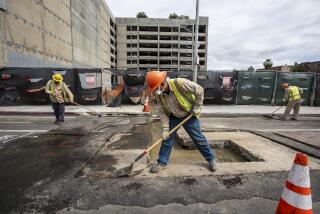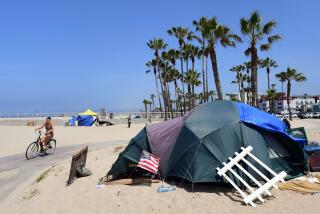Reality Intrudes as Modern-Day Pioneers Pursue Frontier Spirit : Alaska: For decades, any American could claim unreserved federal land here, but no more. Still, some seek simpler life.
CASCADE CREEK, Alaska — No one seemed to be home--just a German shepherd whose wild barking inside the log cabin suggested it was time for the visitor to leave.
Then a boy stepped out from behind a tree, his eyes wide at the sight of a stranger. He dashed off without a word, leading the way to a pile of rocks in the woods. Near the rocks was a hole and, down in the hole, sweating and jabbing with a shovel, was the boy’s father.
Digging a well? the visitor asked.
“It’s a grave,” the man said quietly. “For my wife.”
Nine years have passed since Pete and Rosemary Oliva came to Cascade Creek with the dream of building a cabin in the Alaska wilderness.
By the luck of the draw or the will of God--Pete and Rosemary always believed it to be the latter--they slipped into one of the last spots in America open to homesteading, where a person could get free government land just by living on it.
A wonderful dream. But the rugged reality of frontier living, and sometimes dying, reveals why most people keep it a dream. As anyone at Cascade Creek will tell you, there’s no such thing as free land.
Pete and Rosemary Oliva moved to Alaska in December, 1983, a natural step in a migration that had already taken them from the Florida Keys to the Maine woods.
They were well-suited for life on The Last Frontier. Pete, then 34, was a rugged bear of a man with a wide-ranging resume: pilot, fisherman, diver, welder. Rosemary, then 37, was an adventure-seeker whose crippled leg, the result of childhood polio, could not keep her from climbing mountains.
They envisioned moving straight into a cabin in the woods. Instead, they did as many Alaska newcomers do, living in an apartment in Anchorage, where 41% of Alaska’s 600,000 residents are crammed into an area smaller than Rhode Island.
Breathing got easier when they moved to Sterling, a small town on the Kenai Peninsula, where Pete welded for oil companies. But they still weren’t happy.
“I may as well have been in New Jersey,” Oliva recalled. “I didn’t come to Alaska to weld on oil rigs. That’s not part of the dream.”
They were not the only frustrated dreamers. For decades, any American seeking the pioneer life could stake an Alaska homestead on unreserved federal land under the Homestead Act of 1862. But that law was repealed in 1976, and no federal land has been opened for homesteading in Alaska since 1986.
The state began its own homestead program in 1984, open only to Alaska residents. But much of the land offered was very lonely--beyond roads and so expensive to reach by boat or plane that few could afford the “free” land.
An exception was the 1985 offering near Cascade Creek, right along the Glenn Highway and just 100 miles northeast of Anchorage. Spruce and aspen blanketed a gentle south-facing slope by the Matanuska River. The craggy peaks and glaciered valleys of the Chugach Mountains loomed to the south; the Talkeetna Mountains rose to the north.
More than 1,000 Alaskans applied to stake 40 acres of this wild paradise for their own. Only 15 permits were issued. A lottery chose the winners, and among them were Pete and Rosemary Oliva.
They thanked the Lord and got to work.
First came bushwhacking to find a level home site, then staking boundaries and brushing them clear. The next spring, they moved onto their land, living in a little trailer they hauled in on a rough trail from the road.
Building a home took until August, 1987, when they threw on a roof and moved in: two adults, a 2-year-old boy named Daniel and a big dog named Rocky, all snug in an 18-by-24-foot cabin.
They settled into the rhythms of homestead life. Chopping wood. Hauling water. Bathing in a plastic tub on the floor. Pete hunted for moose, and Rosemary cooked it on the cabin’s tiny stove.
Summer days were spent in hurried preparation for winter’s burrowing-in, when snow piles three feet deep and the sun disappears for two months behind the mountains.
If these were hardships, the Olivas didn’t complain. A self-sufficient life close to nature was why they had come. The hard part was making ends meet.
Oliva said he worked as a pilot in Palmer, 50 miles down the road, until the company went out of business. He found work welding, but injured his arm and had to stop. Now, he carves wooden whale sculptures at home. The pieces sell for $275 in art galleries. It takes so long to make even one, that the work yields less than the minimum wage.
Cash is always short. “When you go out and buy a magazine, you feel like you’re going overboard,” he said.
A lack of economic opportunity dooms many Alaska homesteaders. Farming is such a marginal enterprise that it’s not even required on most homesteads here. All that’s needed to gain title to the land, or prove up, is to build a cabin and live in it for 25 months within five years.
But even that can be difficult. Of the more than 1,600 Alaskans awarded homestead permits since 1984, only 12% have proved up, the state Division of Land said.
At Cascade Creek, three people forfeited after failing to build houses. Three more built dwellings but didn’t meet the residency requirement; they were allowed to buy their land at market value.
Nine homesteaders proved up, but only four now live there year-round--Oliva and three neighbors.
There is Hans Stricker, 31, who complains loudly in English about overbearing government and speaks softly in German to the gray jays that snatch bread from his outstretched hand. He works six days a week as a cook at the Long Rifle Lodge, 10 miles up the road.
There is Doug Maxwell, 46, whose slow gait suggests laziness until you see his homestead, the most polished of any at Cascade Creek, with a cabin, sauna, greenhouse and huge garden. His secret to homesteading: “You find a woman with a good job in town.”
And there is Loren Thomas, 45, with a bushy beard and a wry sense of humor about his plywood cabin, a work forever in progress. “You’ve got to enjoy the process,” he said, gazing at the floor he’d just torn up to fix a bothersome bulge, “because you might never see the end product.”
Oliva knows this. His latest project is a welding shop, squeezed in amid a hundred other tasks.
“You’re constantly fighting,” Oliva said. “Gotta get the wood in for winter. Gotta get the moose. Gotta get the shop and roof done before snow falls. It takes its toll after a while.”
Especially now. For years, Oliva’s source of strength was Rosemary. He considered her the real pioneer, with an indomitable spirit and a smile that could light up a cabin in the dead of winter.
“Woodsmen often say they can’t find a woman who would want to live like this,” Oliva said. “Rosemary was a great woodswoman.”
In February, 1992, she found a lump in her breast. They drove 350 miles to Fairbanks for a mastectomy, but the operation was too late. The cancer had already spread. She battled her illness for months, growing weaker as the pain increased. It would have been easier in town, but there was no talk about moving. Rosemary wanted to stay on the homestead.
They wheeled a hospital chair into the cabin, and Pete tried to keep her comfortable. Independence Day, 1993, was the last time Rosemary walked off the porch without help. She died, cradled in her husband’s arms, last Oct. 3. She was 47.
The ground was frozen, so they buried her in town. This summer, Oliva spent a month chipping a grave out of solid rock, then he brought Rosemary home.
These still are shaky days for him, but Oliva finds solace in simple things: the deep silence of the Alaska night, a moose loping by, even the grim privilege of being able to bury his wife in the yard.
He feels lucky to be a pioneer in a world with so few places left for pioneers. The state stopped offering land for homesteading in 1991, and officials don’t know when or if the practice will start again.
There is satisfaction, too, in watching a boy grow up in the woods. Daniel, now 9, has intense blue eyes and his mother’s strong will. Oliva home-schools him, and the lessons go beyond books. Daniel climbs trees like a squirrel and handles a .22-caliber rifle better than most adults.
Here a boy is free to explore nature, free just to be.
So is a man. And that, Oliva said, is the greatest compensation for a homesteader’s toil.
“There’s a freedom to live the way you want here,” he said. “Some mornings I wake up and think I could have something more secure. But the reality is I’d get bored after a while. I don’t think there’s anything out there to match the abundant life we have here.”
More to Read
Sign up for The Wild
We’ll help you find the best places to hike, bike and run, as well as the perfect silent spots for meditation and yoga.
You may occasionally receive promotional content from the Los Angeles Times.






